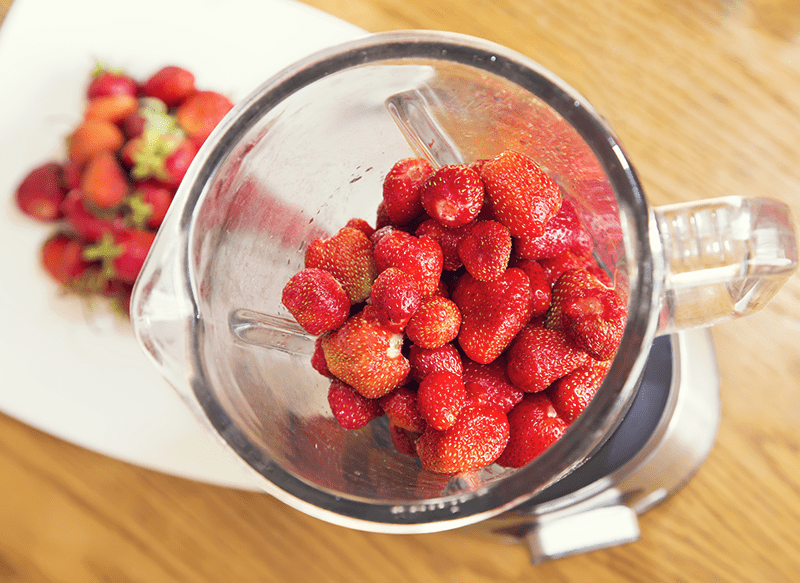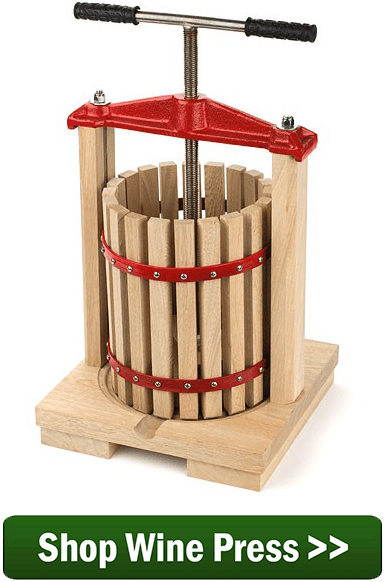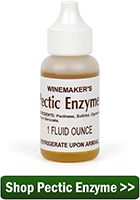 Just started a blueberry wine. Ran the berries through a blender instead of crushing them (lazy I guess). I did not add Campden tablets to it in the beginning, not sure if this is a problem. There is a pulp crust forming on top right now, I stir this each day, should I remove it after 5 or 6 days before I transfer the wine to a carboy?
Just started a blueberry wine. Ran the berries through a blender instead of crushing them (lazy I guess). I did not add Campden tablets to it in the beginning, not sure if this is a problem. There is a pulp crust forming on top right now, I stir this each day, should I remove it after 5 or 6 days before I transfer the wine to a carboy?
Name: Lee P.
State: TN
—–
Hello Lee,
The fact that you did not add Campden tablets before the fermentation is probably not going to be a problem in this case.
The big issue here is that fact that you are using a blender to crush your wine making fruit. What this typically does is cause the resulting wine to be bitter. The over chopping and destroy of the pulp and seeds releases too much tannin into the wine. In turn, the wine will have a lower pH from excessive tannic acid, giving it an unpleasant, bitter-dry, puckering taste.
For future reference, you only want to crush the fruit. Using a blender is way overkill. You only need to make sure that the outer structure of the fruit has been busted in some way. This is something that can quickly be done by hand when dealing with 10 lb. or 15 lb. of fruit such as blueberries. If you are dealing with more fruit than this, then you may want to invest in a fruit crusher, but never use a blender to crush any kind of wine making fruit.
 When the fermentation starts the wine yeast will produce enzymes that will naturally break down the fruit in a more natural, gentler way. The pectic enzyme that is called for in most fruit wine recipes will also help in the regard. For this reason you do not need to do a lot; let the yeast do if for you.
When the fermentation starts the wine yeast will produce enzymes that will naturally break down the fruit in a more natural, gentler way. The pectic enzyme that is called for in most fruit wine recipes will also help in the regard. For this reason you do not need to do a lot; let the yeast do if for you.
With that being said, there are still some things you can do to counteract using a blender to crush wine making fruit:
- Shorten the amount of time you leave the fruit in the fermentation. The shorter the better. I would recommend 2, maybe 3 days at most. This will give less time for the bitterness to leach from the fruit.
- Treat the wine with bentonite after the fermentation has completed. This will help to drop out the excessive tannin and other proteins that where extracted from the fruit. You may even want to use the bentonite more than once.
- Age the wine longer than you normally would. Many of the flavor affects of having too much tannin in the wine can be resolved with additional aging. Instead of 3 to 6 months, think more along the lines of 9 to 15 months. Quite often this will be enough to bring the wine back into a flavorful balance.

I hope this helps you out, and I hope your wine turns out great, regardless. Just remember that using a blender to crush your wine making fruit is not the way to go.
Best Wishes,
Ed Kraus
—–
Ed Kraus is a 3rd generation home brewer/winemaker and has been an owner of E. C. Kraus since 1999. He has been helping individuals make better wine and beer for over 25 years.

I second the "no blender" idea. I use a pastry blender for some of my fruit. Use the one with the flat tines, not the round ones. I smash the fruit in a rounded bottom mixing bowl. Also, a Foley Food Mill works well for larger pitted fruit like chokecherries.
Can a 5 gal plastic water bottle be used for storing wine?
PROBABLY AS LONG AS IT IS FULL. I PREFER THE PLASTIC FERMENTER BUCKETS WITH THE TAP ON THE BOTTOM. RACK IT SEVERAL TIMES,TREAT & BOTTLE IT. THAT IS IF THERE IS ANY LEFT TO BOTTLE.
Matthew, yes, you can use a plastic water jug.
My experience has actually been the opposite with strawberries. My strawberry wine, that took double gold at Indy, was made from berries that were frozen and blended prior to fermentation. I took strawberries from the same batch, cut them up (removed stems plus any bad places) and crushed them (grape crusher). In that experiment the wine from blended strawberries had more fruit flavor and won medals everywhere it was entered. My thinking was that the seeds were so small I was unlikely to break/cut open enough of them to make a difference. I have no way of knowing if this will be the case every time, but these are the results from the one experiment I performed testing this idea.
I was experimenting with fruit that had tiny seeds, I would not have tried it with any fruit whose seeds I thought could possibly be broken in the process.
I just did the same with apricots, did you do anything with the pulp at the bottom. I’m tempted to make a sorbet…
how do you hand crush a small batch of grapes?
Vito, one way to crush grapes without a crusher is to throw the grapes into a bucket and pound them with the sanitized end of a 2X4. If it a very small amount, some people will us a potato masher to crush them. Whatever way you choose to do it, just make sure not to over process, all you need to do is burst the skin. Also be sure to remove the stems before crushing.
Sometimes I use an empty wine bottle in a large s.s. pot.It’s easier to sanitize than a 2×4.
I ran my muscadines through a hand meat grinder to crush , the seeds did not crush but squeezed out the holes. someone told me that that grinding the hulls would make tannen. when I bottle and drink it it has a lot of fis the wine taste great but has a bubbly champange texture . what do I do to stop this? Do you think that it is still ferminting ? what should I do to get it back to wine. I hate to have this happen again . Last year I had 20 gallons ,but hated to give it to my friends because they thought there was something wrong with it.
Timothy, having too much tannin will cause a bitter wine not a bubbly wine. The bubbly wine does indicate that it is fermenting and that you bottled the wine too soon. You should always track the fermentation progress with a hydrometer, it is the only accurate way. You cant stop the fermentation but need to let it complete. If it is bottled, you can try putting it back in bulk to let the fermentation complete. You may need to add more yeast.
I love making muscadine wine, but I hate the process of removing the seeds! After a few gallons my hands are torn to shreds. I might try a hand meat grinder as long as it doesn’t crush the seeds.
I used a blender to chop up raisins in a little water. I didn’t let them go too far but it saved me a lot of chopping.
I freeze all my fruit before blending….put in Camden tabs for 24-30 hrs.before fermentation…after fermentation I refrigerate for 7-10 days until all solids have dropped to the bottom….more work but you can taste each fruit….just an old way of keeping the juice flavor intack…
Iam New to making fruit wine, Why would you add Camden tablets to your fruit prior to fermentation? Don’t they stop fermentation? Also what is bentonite for? Thanks
Yve, You add campden tablets prior to fermentation to destroy any bacteria, mold or wild yeast that may be present on the fruit. You then cover the fermenter with a towel and wait 24 hours for the sulfites to leave before adding the yeast. This way the yeast is not damaged. Bentonite is used to help clarify the wine after fermentation is complete. For more on both topics, please see the article links below.
Using Campden Tablets
https://blog.eckraus.com/using-campden-tablets
What is Bentonite
https://eckraus.com/wine-making-bentonite/
I have used a blender on grapes after crushing. I ferment longer . The advantage that I saw was that the wine has a much better dark red color